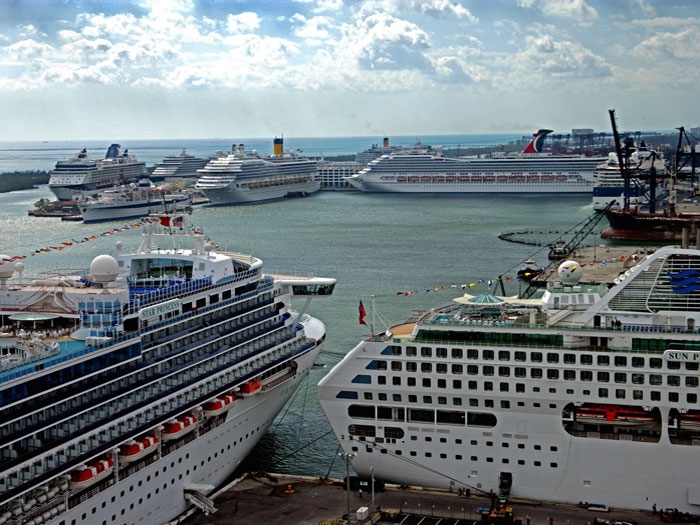
Ports preparing for Hurricane Irma
Written by Marine Log Staff
Port Everglades, one of the world's busiest cruise ports, is making preparations for Hurricane Irma
SEPTEMBER 5, 2017—Ports in the Caribbean and Southeast U.S. are bracing for the impact of Hurricane Irma. For example, Port Everglades, one of the world’s busiest cruise ports accommodating 3.4 million passengers, was notified by the U.S. Coast Guard Captain of the Port that Port Condition WHISKEY will be set for Hurricane Irma starting September 6 at 8 AM. The onset of sustained gale force winds (39 – 54 mph) are predicted within 72 hours.
Port Everglades says that preparations to be addressed and completed are:
- Take due diligence to prepare for potential storm impacts;
- Begin removing all debris and secure potential flying hazards;
- Implement Container stacking plans. Reduce stacking height to no more than four high and no more than two high for hazardous materials;
- Facilities that are unable to meet these requirements due to space constraints must submit a container stacking protocol to the Captain of the Port (COTP) Miami for approval at 305-535-4472;
- Oceangoing vessels moored or at anchor should be prepared to get underway; and
- Hazardous materials should be removed from areas prone to flooding.
Given the current storm track, the USCG Captain of the Port anticipates the setting of Port Condition X-RAY on Thursday, September 7.
X-RAY CONDITION AT SAN JUAN
Meanwhile, effective 8 AM yesterday, the Coast Guard Captain of the Port San Juan, Capt. Eric P. King, set port condition X-RAY for Puerto Rico and the U.S. Virgins Islands due to the possibility of sustained gale force winds greater than 39 mph from Hurricane Irma that may arrive within 48 hours.
The Coast Guard strongly cautions the maritime community to remain vigilant and take the necessary precautions as Irma has been forecasted to have the potential to develop into a Category 4 Hurricane.
During port condition X-RAY port facilities are currently open to all commercial traffic and all transfer operations may continue while X-RAY remains in effect.
Mariners are reminded there are no safe havens in these facilities, and ports are safest when the inventory of vessels is at a minimum. All ocean-going commercial vessels greater than 500 gross tons should make plans for departing the port.
Vessels desiring to remain in port must immediately contact the COTP to receive permission and are required to submit a safe mooring plan in writing. Vessels bound for the U.S. Virgin Islands or Puerto Rico unable to depart 24 hours prior to threatening winds making landfall are advised to seek an alternate destination.
Pleasure craft are advised to seek safe harbor. Maritime and port facilities are reminded to review and update their heavy weather response plans and make any additional preparations needed to adequately prepare in case of a potential impact to the area. Mariners can view the latest port updates on the Coast Guard’s Homeport site.
At this time, Coast Guard Captain of the Port San Juan anticipates setting port condition YANKEE at 8 AM on Sept. 5, for the U.S. Virgin Islands and Puerto Rico. These dates and times are subject to change based on future forecast.
If and when port condition Yankee is set, meaning sustained gale force winds are expected within 24 hours, vessel movement shall be restricted, and all movements must be approved by the captain of the port.
The Coast Guard is warning the public of these important safety messages:
• Secure belongings. Owners of large boats are urged to move their vessels to inland marinas where they will be less vulnerable to breaking free of their moorings or to sustaining damage. Trailer-able boats should be pulled from the water and stored in a place that is not prone to flooding. Those who are leaving their boats in the water are reminded to remove EPIRBs and to secure life rings, lifejackets and small boats. These items, if not properly secured, can break free and require valuable search and rescue resources be diverted to ensure people are not in distress.
• Stay clear of beaches. Wave heights and currents typically increase before a storm makes landfall. Even the best swimmers can fall victim to the strong waves and rip currents caused by hurricanes. Swimmers should stay clear of beaches until local lifeguards and law enforcement officials say the water is safe.
• Be prepared. Area residents should be prepared by developing a family plan, creating a disaster supply kit, having a place to go, securing their home and having a plan for pets. Information can be found at the National Hurricane Center’s webpage.
• Stay informed. The public should monitor the progress and strength of the storm through local television, radio and Internet. Boaters can monitor its progress on VHF radio channel 16. Information can also be obtained on small craft advisories and warnings on VHF radio channel 16. Information on how to prepare your boat or trailer for a hurricane can be found at the Coast Guard’s Storm Center webpage: https://www.uscg.mil/news/stormcenter/.





Leave a Reply
You must be logged in to post a comment.